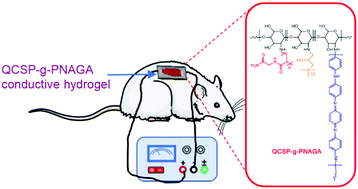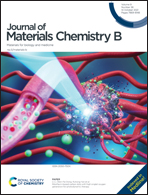Conductive dual hydrogen bonding hydrogels for the electrical stimulation of infected chronic wounds†
Abstract
Electrical stimulation (ES) via rigid electrodes near the wound is one of the promising approaches for chronic wound treatment, but it is unable to stimulate the whole wound area and treat infected wounds. In this study, a tough conductive hydrogel was prepared by the copolymerization of N-acryloyl glycinamide (NAGA) with quaternized chitosan-g-polyaniline (QCSP). The hydrogel showed a similar conductivity to the human skin and robust mechanical properties due to the dual hydrogen bonding motifs. The grafted polyaniline segments and functionalized quaternary ammonium groups showed intense antimicrobial activity against Pseudomonas aeruginosa and Staphylococcus aureus biofilms. The in vivo assay in diabetic rats proves that the ES via the conductive hydrogel was more effective in promoting the healing of infected wounds than the conventional ES via rigid electrodes. Due to the excellent flexibility and antibacterial properties, this conductive hydrogel shows great promise for infected chronic wound treatment.



 Please wait while we load your content...
Please wait while we load your content...